Preventing Water Damage in the Bathroom
Preventing Water Damage in the Bathroom
Blog Article
Do you find yourself searching for ideas on How to Prevent Bathroom Water Damage?

The shower room is incredibly at risk for wet build-up as well as potential water damage as a result of the constant use of water in it. This article provides basic examination techniques to help discovering water damages dangers.
The constant use water in the bathroom makes it extremely vulnerable for moist accumulation and also possible water damages. By evaluating it on a regular basis, you can lower water relevant problems.
The complying with set of evaluations is easy to perform and also need to be done as soon as in every three months in order to keep your restroom in good shape and to stop possible water problems triggered by the bathtub, the shower, pipe joints and also plumbing, sinks, cupboards, and the commode
Do not disregard performing these examinations as well as be comprehensive while performing them. Remember that these easy inspections can conserve you a lot of cash by offering early signs for water damage
Sinks and also Cabinets
Sinks as well as cabinets are revealed to wetness and also moisture daily and also are frequently overlooked. Evaluate on a regular basis under the sink as well as on the countertop over it. Repair any drip in the catch as it may recommend drainpipe problems. Check out the sink, sluggish draining pipes might suggest a blocked drainpipe. Replace sink seals if they are fractured or loose.
Bathtub as well as Shower
The shower and bath tub need unique interest and upkeep. Check the floor tiles and replace if broken. See to it that there is no missing out on grout in between the ceramic tiles. Inspect as well as replace split caulking at joints where the walls fulfill the floor or the bath tub. Clogged drains pipes and pipelines problems will certainly prevent the tub from drying as well as might suggest significant problems under the tub. Consult with an expert quickly to avoid architectural damage. Focus on stainings or soft areas around the bath tub walls as they may show an internal leakage.
Plumbing
Signs for water damages are hard to find since many pipelines are installed inside the walls.
Pay unique focus to flooring as well as wall surfaces moisture as well as discolorations as they may indicate an undetectable plumbing trouble. Check wetness degrees in adjacent rooms as well.
The Bathroom
The commode is a vulnerable water junction. Inspect the water lines as well as look for leaks around the commode seat, in the hose pipe, as well as under the water container. If you spot any type of indicators of moisture on the floor around the bathroom, look for leakages in the toilet rim and storage tank seals.
Understand that hanging commode dish antiperspirants raises the opportunities for obstructions.
Water Damage Signs In The Bathroom To Avoid Cleanup
Musty smell
This is one of the easiest signs to catch because musty smells are so odorous. The damp, earthy, moldy smell should be a big red flag. The smell will develop when moisture gets trapped in surfaces, and begins to facilitate mold growth. Leaking pipes under cabinets, inside walls, and behind shower fixtures will cause moisture to stay trapped and not dry, which will lead to mold growth and spread. As soon as you notice any musty smells in your bathroom, have it checked for hidden water damage and cleanup signs.
Visible mold
If the smell isn’t there to give it away, sometimes you will actually see mold growth. Finding mold in your bathroom is a serious problem, because mold is very harmful to your health. By the time mold growth is visible, it also means that water damage has already occurred and been present for some time. The only way the mold problem can be resolved is to find the source of the moisture and get it stopped. To safely and adequately remove mold, you need to have professionals handle the remediation. Do not waste any time in getting mold problems addressed, fixed, and sanitized so that you can protect you and your family from the many respiratory symptoms caused by mold exposure.
Damaged floors
Bathroom floors should be able to withstand some exposure to water while still remaining in good condition. However, when excess exposure or water leaks occur, they will begin to damage even the most water-resistant flooring. If you notice any cracking, bubbling, staining, or warping on your bathroom floors, there is probably a water leak somewhere causing the distortion. If you notice areas of the floor have become softer, or even have a spongy feeling, there is probably damage to the subfloor. Subflooring is typically made up of plywood. When plywood is exposed to water or moisture, it will absorb it. Once it has become saturated, the weight of the excess water will cause the wood to swell and soften. Check the floors in your bathroom frequently to catch any of these sings before they lead to damaged subflooring.
Changes on walls
When water leaks behind walls, it will cause changes in the drywall. Peeling plaster, blistering paint, and soggy wallpaper are all good indicators that excess water is building up behind the wall. Water leaking behind drywall will cause it to swell and be soft to the tough. If you start to notice gaps along the trim of your walls, or where tile meets the wall, it could also be a strong indicator that there is a leak behind the wall. Any changes, distortion, or damage on the walls should be evaluated as soon as you notice it to prevent further water damage and cleanup.

I discovered that blog entry about How to Fix a Water Damage Bathroom when doing a search on the web. Don't hesitate to take the time to share this page if you liked it. Thanks a bunch for your time. Visit us again soon.
More Details Report this page